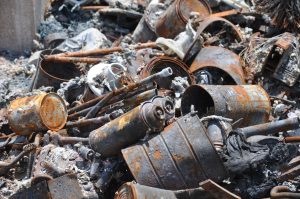In the ashes of the 259 homes burned by the High Park Fire in June are the toxic remnants of 21st century life: household chemicals and mercury-filled light bulbs, heavy-metal components from electronics, melted microwave ovens and coolant-filled refrigerators, fluids from cars and trucks reduced to steel shells, perhaps even asbestos or lead from building materials.

That’s why the state of Colorado considers burned structural debris hazardous waste and has strict regulations about how to dispose of it. The materials must be removed properly and delivered to a landfill that can handle them, such as the Larimer County facility on South Taft Hill Road. As of Oct. 29, the landfill had received 2,424 cubic yards of structural ash from the High Park burn area. The privately owned North Weld Landfill near Ault and Front Range Landfill also accept debris from the fire area.
According to guidance issued by the Colorado Department of Public Health and Environment in August, soil under the burned area should be scraped to ensure all the debris is removed. Materials should be thoroughly wetted to reduce dust and “burrito-wrapped” inside 6-mil plastic sheeting. The material should then be placed in an end-dump roll-off with the top sealed with plastic to secure it during transport.
And once the dump-truck full of debris gets to the landfill, there are fees. No county or state demolition permit is required to remove debris from structures totally destroyed by the fire.
But the fees to dump structural debris at the Larimer County landfill are $10.50 per cubic yard – double the usual $5.25 rate for loose waste – to cover special handling required by the state health department. A pickup truck can haul about two to three cubic yards of wet ash, while a dump truck can carry about 10 to 20 cubic yards.
Stephen Gillette, director of the county’s Solid Waste Department, explained that while a cubic yard of normal waste compacts to about one-third of a yard in the landfill, the fire debris actually takes up two to three cubic yards of space because the health department requires it to be covered with dirt before it is compacted.
“The commodity we have to sell at the landfill is space,” he said.
In all, hiring a contractor to clean up a burned property can run into the thousands of dollars, even if insurance is available to cover it.
Doing it yourself can be just as expensive as well as time-consuming. Wouldn’t it be easier, faster and cheaper to hire a guy with a bulldozer to just plow it all under and cover it with a nice deep layer of dirt?
Maybe, but it is also illegal, not to mention really, really bad for the mountain environment.
“It’s important that landowners don’t impact the future development potential of their property,” explained Doug Ryan, environmental health planner with the Larimer County Health Department.
“Getting [structural waste] off site makes more sense than burying it where they may want to build or where it can affect the water quality in their well.”
Speaking of water quality, burying potentially hazardous waste on site increases the likelihood of toxins leaching into the Poudre River, which is already receiving additional runoff of ash and forest debris from the burn area. Ryan said both Fort Collins and Greeley have been monitoring the river closely since the fire and have not found increased levels of toxic materials in the water yet.
That’s not to say structural waste hasn’t already been buried in the High Park burn area. Ryan confirmed that his department has investigated “a few cases” of illegal waste disposal.
“We’ve received complaints from other contractors, or landowners who had questions about what their contractor wanted to do,” he said. “Our inspectors visit with the landowner and the contractor and try to work it out.”
In cases where an illegal burial was reported after the fact, Ryan said the contractor has been required to dig up the debris and dispose of it properly in the landfill.
Ryan admits that his department doesn’t have inspectors on the ground in the burn area all the time, but said they respond when complaints are received. Right now, the department is taking an “educational” approach, he said, but “may be more regulatory in the future.”
Ryan added the county health department has also been coordinating its responses with the state health department, which has the authority to assess penalties of up to $15,000 per day for repeated violations of hazardous waste disposal regulations.
Suzanne Bassinger, the county’s new fire recovery manager, said the best way for property owners to protect themselves against illegal waste disposal is to verify what the contractor plans to do with the waste, then watch when the crew is on site. If that’s not possible, landowners who question the work can have test pits dug by a third party to verify there is no toxic debris under the soil before signing off on the job.
For structural debris that remains on the property, the county still has some lined Dumpsters it will deliver to the site — or as close as possible for collection trucks to pick up — at no charge, through a $45,000 grant from the High Park Fire Fund that collected donations over the summer.
For more information, call the Larimer County Landfill at 970-498-5767. Complaints about improper disposal can be made to 970-498-6775.
Support Northern Colorado Journalism
Show your support for North Forty News by helping us produce more content. It's a kind and simple gesture that will help us continue to bring more content to you.
BONUS - Donors get a link in their receipt to sign up for our once-per-week instant text messaging alert. Get your e-copy of North Forty News the moment it is released!
Click to Donate
